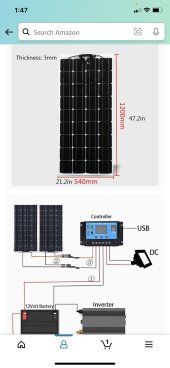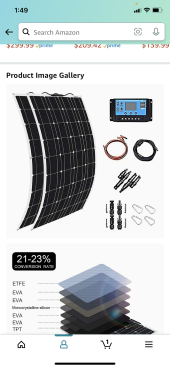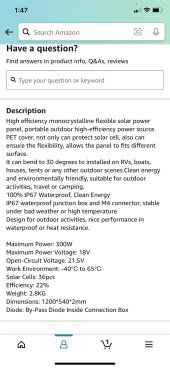You are using an out of date browser. It may not display this or other websites correctly.
You should upgrade or use an alternative browser.
You should upgrade or use an alternative browser.
Charge controller
- Thread starter btemplet
- Start date
That's not a problem at all. You'll rarely get exactly 600W from the panels and your batteries would have to be at 12V exactly while getting the full 600W to reach 50A charging current. It would be fine even if you had 800W. The controller just wouldn't be able to take advantage of the extra potential.
The important key is that the Voc of your panel arrangement doesn't exceed the max input voltage of the controller. And Voc goes up in the cold.
The important key is that the Voc of your panel arrangement doesn't exceed the max input voltage of the controller. And Voc goes up in the cold.
chrisski
Solar Boondocker
- Joined
- Aug 14, 2020
- Messages
- 5,192
I have a 600 watt array and I think 50 amps is perfect for a 12 volt system. THis allows for some expansion by adding cells on later.
With my Victron 100 volt 50 amp controller, my flat roof panels have produced 25 to 30 charging amps to the battery max in the flat configuration. In theory, they may get between 36 amps and 42 charging amps if the panel is pointed and angled at the sun. I’ve gotten 6 to 7 amp charging to the battery with a 100 watt panel that way.
If you see no reason to ever expand, IME if these are flat panels, you may get by with a 30 amp controller Based off what I’ve seen for max real production.
With my Victron 100 volt 50 amp controller, my flat roof panels have produced 25 to 30 charging amps to the battery max in the flat configuration. In theory, they may get between 36 amps and 42 charging amps if the panel is pointed and angled at the sun. I’ve gotten 6 to 7 amp charging to the battery with a 100 watt panel that way.
If you see no reason to ever expand, IME if these are flat panels, you may get by with a 30 amp controller Based off what I’ve seen for max real production.
Thanks Ihave 2 100 watt Renogy’s I’m not sure what brand the 2 300 watts can I put them on the same charge controller or should I use 2 charge controllers the charge controller I have a pwm for two 100 watts and a mppt for the 2 300 watts I have coming
chrisski
Solar Boondocker
- Joined
- Aug 14, 2020
- Messages
- 5,192
Don’t put the odd sized panels (Both 300 watt panels and two of the 100 watt panels) on the same charge controller. This seems like a good plan:
Just keep in mind, with the PWM if this is a 24 volt system both panels will likely need to be in series, and if its a 12 volt system, both panels will likely need to be in parallel.
In my signature block there’s a link “Mixing and Matching Solar Panels” and there‘s some math that says you start with six hundred watts of panels, but because of voltage and wattage mismatches, when you add two hundred watts more of panels, you have less than you started with.
a pwm for two 100 watts and a mppt for the 2 300 watts I have coming
Just keep in mind, with the PWM if this is a 24 volt system both panels will likely need to be in series, and if its a 12 volt system, both panels will likely need to be in parallel.
In my signature block there’s a link “Mixing and Matching Solar Panels” and there‘s some math that says you start with six hundred watts of panels, but because of voltage and wattage mismatches, when you add two hundred watts more of panels, you have less than you started with.
12VoltInstalls
life passes by too quickly to not live in freedom
The only other thing is some people have occasionally suggested that a PWM with a MPPT on the same bank make their mppt behave funny.
I think for most people this is not a problem but something to be aware of.
On the other hand I saw that the little Epever mppt was like $50 on amazone recently. The two 100W panels in series on that could be a nice bonus.
If it were me I might offload the 100W panels and get one more 200W for 2S2P
Or if the specs are close, the two 100W panels in series with one 200W panel in one string and two 200W panels in series for a second string could be a possibility.
I have running 600W of 100W panels running on a 50A mppt right now. A couple late gizmo parts- and the snowy weather- are the only reason I’m not running 800W right now. A part or two and a couple hours and I could plug them in.
I have two arrays facing 90 degrees apart so that I spread my input over the day. Whatever I ‘lose’ isn’t really lost: I gain daily exposure time.
I think for most people this is not a problem but something to be aware of.
On the other hand I saw that the little Epever mppt was like $50 on amazone recently. The two 100W panels in series on that could be a nice bonus.
If it were me I might offload the 100W panels and get one more 200W for 2S2P
Or if the specs are close, the two 100W panels in series with one 200W panel in one string and two 200W panels in series for a second string could be a possibility.
I have running 600W of 100W panels running on a 50A mppt right now. A couple late gizmo parts- and the snowy weather- are the only reason I’m not running 800W right now. A part or two and a couple hours and I could plug them in.
I have two arrays facing 90 degrees apart so that I spread my input over the day. Whatever I ‘lose’ isn’t really lost: I gain daily exposure time.
The only other thing is some people have occasionally suggested that a PWM with a MPPT on the same bank make their mppt behave funny.
I think for most people this is not a problem but something to be aware of.
On the other hand I saw that the little Epever mppt was like $50 on amazone recently. The two 100W panels in series on that could be a nice bonus.
If it were me I might offload the 100W panels and get one more 200W for 2S2P
Or if the specs are close, the two 100W panels in series with one 200W panel in one string and two 200W panels in series for a second string could be a possibility.
I have running 600W of 100W panels running on a 50A mppt right now. A couple late gizmo parts- and the snowy weather- are the only reason I’m not running 800W right now. A part or two and a couple hours and I could plug them in.
I have two arrays facing 90 degrees apart so that I spread my input over the day. Whatever I ‘lose’ isn’t really lost: I gain daily exposure time.
MichaelK
Solar Wizard
What you need to focus on is the output voltage of each string of panels. What is the Vmp of these new 300W panels. If they are ~36-37Vmp, then you might be able to make it work. If you wire your two Renogy 100W panels in series it will be around 18Vmp + 18Vmp = 36Vmp. That would be one 36V string putting out about 5A. Each 300W panel would be putting out ~36-37Vmp at ~8A. So, if the two 100W panels are in series, along with the two 300W panels in parallel, you'd have three parallel 36V strings putting out 5A + 8A + 8A = 21A at ~36Vmp. As long as each string is 36V, they will be compatible with each other, as long as each voltage string does not vary by more than 5%. This will work best on a 12V system, though likely to be OK on a 24V system, using the MPPT controller you have. I'd give away or sell the PWM controller.Thanks Ihave 2 100 watt Renogy’s I’m not sure what brand the 2 300 watts can I put them on the same charge controller or should I use 2 charge controllers the charge controller I have a pwm for two 100 watts and a mppt for the 2 300 watts I have coming
There is not any info on the panels but according to specs online they are notWhat you need to focus on is the output voltage of each string of panels. What is the Vmp of these new 300W panels. If they are ~36-37Vmp, then you might be able to make it work. If you wire your two Renogy 100W panels in series it will be around 18Vmp + 18Vmp = 36Vmp. That would be one 36V string putting out about 5A. Each 300W panel would be putting out ~36-37Vmp at ~8A. So, if the two 100W panels are in series, along with the two 300W panels in parallel, you'd have three parallel 36V strings putting out 5A + 8A + 8A = 21A at ~36Vmp. As long as each string is 36V, they will be compatible with each other, as long as each voltage string does not vary by more than 5%. This will work best on a 12V system, though likely to be OK on a 24V system, using the MPPT controller you have. I'd give away or sell the PWM controller.
according specs the 300watt panels coming in will be 18VmpWhat you need to focus on is the output voltage of each string of panels. What is the Vmp of these new 300W panels. If they are ~36-37Vmp, then you might be able to make it work. If you wire your two Renogy 100W panels in series it will be around 18Vmp + 18Vmp = 36Vmp. That would be one 36V string putting out about 5A. Each 300W panel would be putting out ~36-37Vmp at ~8A. So, if the two 100W panels are in series, along with the two 300W panels in parallel, you'd have three parallel 36V strings putting out 5A + 8A + 8A = 21A at ~36Vmp. As long as each string is 36V, they will be compatible with each other, as long as each voltage string does not vary by more than 5%. This will work best on a 12V system, though likely to be OK on a 24V system, using the MPPT controller you have. I'd give away or sell the PWM controller.
I just did this same type of mix and match. I had a 'solar suitcase' - 160w of folding portable panels that came with a very basic pwm charge controller. I was losing a lot of voltage through the connect leads - 22' of 10awg wire to the batteries.
Then I wanted to add more to the RV roof, so I put 2- 215w panels up there in series on their own mppt controller. I read that some mppt controllers don't play well with pwm - their pulsing prevents the mppt from getting a good read on battery voltage. So I took the pwm off the panels and installed an mppt (yeah, a 10A Epever Tracer was just $50) and changed the portable panels over to series wired as well, and moved the controller inside closer to the battery bus. Now I get the full panel amps rating out of the portables, which supplant the bigger output from the roof panels. If we're under trees/shaded, or early or late, or low sun, the portables out-perform the ones flat on the roof at more than twice their size. Lots of benefits with this setup. The only downside is you do have to futz with the portables when you setup camp.
So now I get less voltage drop on both arrays since they're in series, both controllers work well with the other on the same bus, and both live happily ever after. I only plug in the portables when I need them. And I can orient them to best sun exposure

Then I wanted to add more to the RV roof, so I put 2- 215w panels up there in series on their own mppt controller. I read that some mppt controllers don't play well with pwm - their pulsing prevents the mppt from getting a good read on battery voltage. So I took the pwm off the panels and installed an mppt (yeah, a 10A Epever Tracer was just $50) and changed the portable panels over to series wired as well, and moved the controller inside closer to the battery bus. Now I get the full panel amps rating out of the portables, which supplant the bigger output from the roof panels. If we're under trees/shaded, or early or late, or low sun, the portables out-perform the ones flat on the roof at more than twice their size. Lots of benefits with this setup. The only downside is you do have to futz with the portables when you setup camp.
So now I get less voltage drop on both arrays since they're in series, both controllers work well with the other on the same bus, and both live happily ever after. I only plug in the portables when I need them. And I can orient them to best sun exposure

Last edited:
sunshine_eggo
Happy Breffast!
There is not any info on the panels but according to specs online they are not
according specs the 300watt panels coming in will be 18Vmp
If all your panels have the same or nearly the same Vmp, that makes it easy.
2S 100W panels in parallel with 2S 300W panels - would work fine on a single MPPT 50 on 12/24V system. You might lose a little due to the current limit, but probably only from about 11a-1p with perfectly oriented/tilted panels. If panels are not perfectly aligned, you may never lose anything.
MichaelK
Solar Wizard
This seems very unlikely? I've never heard of a 300W 12V panel before? Are you sure it's not a "300W kit" containing three 100W panels? Can you please provide a link to the specs you are referring to?according specs the 300watt panels coming in will be 18Vmp
In any case, matching string voltages WILL work, as long as voltages match up by less than 5% deviation.
I don’t know how to send a link but here pictures of the specsThis seems very unlikely? I've never heard of a 300W 12V panel before? Are you sure it's not a "300W kit" containing three 100W panels? Can you please provide a link to the specs you are referring to?
In any case, matching string voltages WILL work, as long as voltages match up by less than 5% deviation.
Attachments
Bud Martin
Solar Wizard
- Joined
- Aug 27, 2020
- Messages
- 4,843
It looks like 300W is for two panels combined since it shows two panels in the kit, so more likely to be 150W panel. If they cannot provide full spec of the panel I.E. VOC, Vmp, Imp, Isc, etc then I doubt if they actually know what they are selling.
12VoltInstalls
life passes by too quickly to not live in freedom
Plus: if you return that you will more than likely be able to purchase rigid, longer lasting, and compatible panels for much less money. An mppt will charge well if you give it good input.looks like 300W is for two panels combined since it shows two panels in the kit, so more likely to be 150W panel.
sunshine_eggo
Happy Breffast!
Sanity check:
Panel size: 1.2m x .54m = .648m^2
1000W/m^2 * .648m^2 = 648W (amount of solar energy hitting the panel).
648W * 20% efficiency = 130W
They claim 21-23% efficiency, but I don't believe it.
I bet this is a 125W panel, and they've "rounded up."
Panel size: 1.2m x .54m = .648m^2
1000W/m^2 * .648m^2 = 648W (amount of solar energy hitting the panel).
648W * 20% efficiency = 130W
They claim 21-23% efficiency, but I don't believe it.
I bet this is a 125W panel, and they've "rounded up."
pollenface
Solar Addict
The only other thing is some people have occasionally suggested that a PWM with a MPPT on the same bank make their mppt behave funny.
Not in my case.
All controllers run the same charge parameters. The PWM tends to do most of the work and the MPPT's pick up the slack if needed.
chrisski
Solar Boondocker
- Joined
- Aug 14, 2020
- Messages
- 5,192
THat’s not supposed to happen. ?Not in my case.
All controllers run the same charge parameters. The PWM tends to do most of the work and the MPPT's pick up the slack if needed.
Similar threads
- Replies
- 7
- Views
- 423
- Replies
- 2
- Views
- 174
- Replies
- 5
- Views
- 142
- Replies
- 6
- Views
- 269





